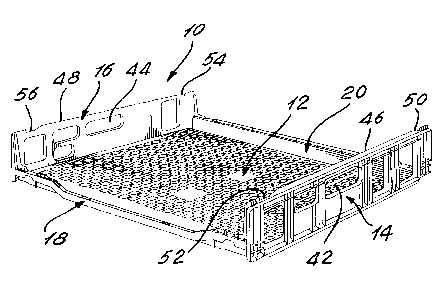Some of the information on this Web page has been provided by external sources. The Government of Canada is not responsible for the accuracy, reliability or currency of the information supplied by external sources. Users wishing to rely upon this information should consult directly with the source of the information. Content provided by external sources is not subject to official languages, privacy and accessibility requirements.
Any discrepancies in the text and image of the Claims and Abstract are due to differing posting times. Text of the Claims and Abstract are posted:
| (12) Patent: | (11) CA 2120881 |
|---|---|
| (54) English Title: | STACKABLE LOAD BEARING TRAY |
| (54) French Title: | PLATEAU PORTEUR GERBABLE |
| Status: | Expired and beyond the Period of Reversal |
| (51) International Patent Classification (IPC): |
|
|---|---|
| (72) Inventors : |
|
| (73) Owners : |
|
| (71) Applicants : |
|
| (74) Agent: | LAVERY, DE BILLY, LLP |
| (74) Associate agent: | |
| (45) Issued: | 2005-08-30 |
| (22) Filed Date: | 1994-04-08 |
| (41) Open to Public Inspection: | 1995-10-09 |
| Examination requested: | 2001-04-03 |
| Availability of licence: | N/A |
| Dedicated to the Public: | N/A |
| (25) Language of filing: | English |
| Patent Cooperation Treaty (PCT): | No |
|---|
| (30) Application Priority Data: | None |
|---|
The disclosure herein describes a stackable tray which is formed of a body of rigid plastic material with a bottom wall integrally formed with opposite side walls and front and rear walls; each side wall is provided with an upper edge flange which is engageable in a recessed area defined in the lower edge of a superposed similarly constructed tray. The location of the recessed area with respect to the upper edge flange is such as to force outwardly the side walls during stacking engagement thus causing internal stresses in the bottom wall which counteract the sagging which occurs when loads are supported on the bottom wall.
La présente invention concerne un plateau empilable qui est formé d'un corps en matière plastique rigide avec une paroi de fond entièrement formée avec des parois latérales opposées et des parois avant et arrière; chaque paroi latérale est dotée d'une bride de bord supérieur pouvant être insérée dans une zone encastrée définie dans le bord inférieur d'un plateau superposé de même type. L'emplacement de la zone encastrée par rapport à la bride de bord supérieur est de nature à exercer une force vers l'extérieur sur les parois latérales lors de l'empilement, provoquant ainsi des contraintes internes sur la paroi de fond qui contrecarrent l'affaissement se produisant lorsque des charges sont supportées par la paroi de fond.
Note: Claims are shown in the official language in which they were submitted.
Note: Descriptions are shown in the official language in which they were submitted.

2024-08-01:As part of the Next Generation Patents (NGP) transition, the Canadian Patents Database (CPD) now contains a more detailed Event History, which replicates the Event Log of our new back-office solution.
Please note that "Inactive:" events refers to events no longer in use in our new back-office solution.
For a clearer understanding of the status of the application/patent presented on this page, the site Disclaimer , as well as the definitions for Patent , Event History , Maintenance Fee and Payment History should be consulted.
| Description | Date |
|---|---|
| Time Limit for Reversal Expired | 2014-04-08 |
| Letter Sent | 2013-04-08 |
| Letter Sent | 2012-04-12 |
| Inactive: Correspondence - Transfer | 2012-04-04 |
| Grant by Issuance | 2005-08-30 |
| Inactive: Cover page published | 2005-08-29 |
| Pre-grant | 2005-06-16 |
| Inactive: Final fee received | 2005-06-16 |
| Notice of Allowance is Issued | 2004-12-22 |
| Letter Sent | 2004-12-22 |
| Notice of Allowance is Issued | 2004-12-22 |
| Inactive: Approved for allowance (AFA) | 2004-12-07 |
| Amendment Received - Voluntary Amendment | 2004-03-05 |
| Inactive: S.30(2) Rules - Examiner requisition | 2003-10-07 |
| Amendment Received - Voluntary Amendment | 2001-09-19 |
| Inactive: Application prosecuted on TS as of Log entry date | 2001-07-18 |
| Inactive: Adhoc Request Documented | 2001-07-18 |
| Inactive: Delete abandonment | 2001-07-18 |
| Letter Sent | 2001-07-18 |
| Inactive: Status info is complete as of Log entry date | 2001-07-18 |
| Inactive: Abandon-RFE+Late fee unpaid-Correspondence sent | 2001-04-09 |
| All Requirements for Examination Determined Compliant | 2001-04-03 |
| Request for Examination Requirements Determined Compliant | 2001-04-03 |
| Application Published (Open to Public Inspection) | 1995-10-09 |
There is no abandonment history.
The last payment was received on 2005-04-05
Note : If the full payment has not been received on or before the date indicated, a further fee may be required which may be one of the following
Please refer to the CIPO Patent Fees web page to see all current fee amounts.
Note: Records showing the ownership history in alphabetical order.
| Current Owners on Record |
|---|
| IPL INC. |
| Past Owners on Record |
|---|
| MAURICE BEAUCHAMP |
| MICHEL LANOUE |